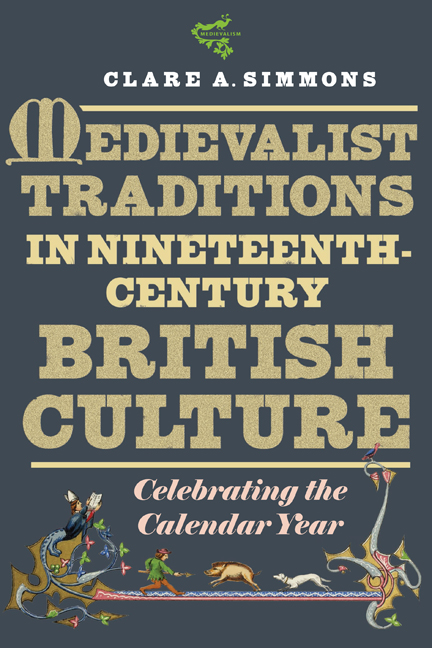Book contents
- Frontmatter
- Dedication
- Contents
- List of Illustrations
- Preface
- Acknowledgments
- List of Abbreviations
- Introduction: Medievalizing Time
- 1 The Christian and Not-So-Christian Year
- 2 Medievalist Calendar Experiments
- 3 Christmas Becomes a Season
- 4 Winter Love: St Agnes and St Valentine
- 5 Rites of Spring: Imagining Origins
- 6 Summer Festivals: Religion in Performance
- 7 Fragmented Autumn: Harvest-Home to Lord Mayor's Show
- Epilogue: Christmas Ghosts
- Bibliography
- Index
- Miscellaneous Endmatter
1 - The Christian and Not-So-Christian Year
Published online by Cambridge University Press: 09 February 2021
- Frontmatter
- Dedication
- Contents
- List of Illustrations
- Preface
- Acknowledgments
- List of Abbreviations
- Introduction: Medievalizing Time
- 1 The Christian and Not-So-Christian Year
- 2 Medievalist Calendar Experiments
- 3 Christmas Becomes a Season
- 4 Winter Love: St Agnes and St Valentine
- 5 Rites of Spring: Imagining Origins
- 6 Summer Festivals: Religion in Performance
- 7 Fragmented Autumn: Harvest-Home to Lord Mayor's Show
- Epilogue: Christmas Ghosts
- Bibliography
- Index
- Miscellaneous Endmatter
Summary
THE ENGLISH church of the nineteenth century still maintained an elaborate calendar. The Elizabethan version of the Book of Common Prayer, printed in 1559, expunged most of the saints’ days recognized by Roman Catholics but retained those commemorating the Apostles. An explanatory statement, “Of Ceremonies, Why Some Be Abolished and Some Retained,” claims that “some at first were of godly intent and purpose devised and yet at length turned to vanity and superstition, some entered into the Church by undiscreet devotion and such a zeal as was without knowledge.” The goal is to retain the ceremonies “which pertain to edification,” yet to recognize that “the burden of them was intolerable” even in early Christian times. The calendar was still very important since the schedule of Bible readings was set out by date. In combination, Matins and Evensong, the two required services for every day, covered the entire Book of Psalms in a month. Moreover, while many holy days were fixed by date, those calculated in relation to Easter varied according to the “Golden Number,” the nineteen-year table being included in the prefatory material and an “Almanac for Thirty Years” calculating the date of Easter between 1559 and 1588. The months are listed from January to December with the surviving saints’ days and readings for morning and evening prayer, together with the signs of the Zodiac, perhaps implying a connection between the Christian year and the solar year. Complicating this further is the fact that before calendar reform in England, the new year was considered to start in March, and the Christian year in Advent.
By the Victorian period, the calendar-related materials in the Book of Common Prayer looked somewhat different, even though the book retained “Of Ceremonies.” The signs of the Zodiac had been dropped from the calendar, but as early as the time of William Laud the number of saints’ days had been expanded. The Annotated Book of Common Prayer (1867) lists in addition to the Apostles and other Gospel figures twenty “Martyrs in the Age of Persecution,” twenty-one “Martyrs and other Saints especially connected with England,” and a few more saints besides. The comparative calendar that follows shows that the Victorian Church of England had far less saints’ days than before the Reformation, but still had several days of special religious significance every month.
- Type
- Chapter
- Information
- Medievalist Traditions in Nineteenth-Century British CultureCelebrating the Calendar Year, pp. 15 - 38Publisher: Boydell & BrewerPrint publication year: 2021

